The luxury vinyl tile flooring market is estimated to be valued at USD 34.5 billion in 2025 and is projected to reach USD 88.7 billion by 2035, registering a compound annual growth rate (CAGR) of 9.9% over the forecast period.
The luxury vinyl tile (LVT) flooring market is valued at USD 34.5 billion in 2025 and is expected to reach USD 88.7 billion by 2035, with a CAGR of 9.9%. From 2021 to 2025, the market grows from USD 21.5 billion to USD 34.5 billion, passing through intermediate values of USD 23.7 billion, 26.0 billion, 28.6 billion, and 31.4 billion. This early growth phase is driven by increasing demand for affordable, durable, and visually appealing flooring solutions in both residential and commercial spaces. The market benefits from rapid urbanization, rising construction activities, and improvements in LVT technology, making it an attractive alternative to traditional flooring materials.
Between 2026 and 2030, the market continues to expand, moving from USD 34.5 billion to USD 55.3 billion, with values passing through USD 37.9 billion, 41.7 billion, 45.8 billion, and 50.3 billion. The market’s growth momentum intensifies due to innovations in design, improved manufacturing techniques, and the growing acceptance of LVT as a premium flooring option. From 2031 to 2035, the market reaches USD 88.7 billion, with intermediate values of USD 60.8 billion, 66.8 billion, 73.4 billion, and 80.7 billion. As the market matures, it begins to approach its saturation point, with growth becoming more reliant on continuous product innovation, customization options, and the increasing preference for sustainable building materials.
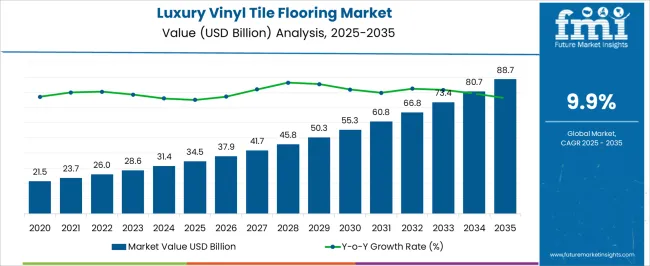
| Metric | Value |
|---|---|
| Luxury Vinyl Tile Flooring Market Estimated Value in (2025 E) | USD 34.5 billion |
| Luxury Vinyl Tile Flooring Market Forecast Value in (2035 F) | USD 88.7 billion |
| Forecast CAGR (2025 to 2035) | 9.9% |
The flooring market is the largest contributor, accounting for approximately 35-40%, as LVT is a rapidly growing segment within the broader flooring category. As consumer demand for durable, cost-effective, and stylish flooring options increases, LVT continues to capture market share from traditional flooring solutions like hardwood and carpet. The construction market follows with around 25-30%, driven by the rise in residential and commercial building projects globally. As new constructions and renovations continue, the need for affordable yet high-quality flooring solutions like LVT grows.
The home improvement and renovation market contributes about 15-18%, as homeowners increasingly opt for LVT due to its easy installation, affordability, and aesthetic appeal. LVT is seen as an ideal choice for home renovation projects. The interior design market accounts for approximately 10-12%, as interior designers favor LVT for its versatility and ability to mimic high-end materials like hardwood and stone. Finally, the real estate market contributes around 8-10%, with developers and investors opting for LVT in both residential and commercial properties due to its durability, modern aesthetic, and cost-effectiveness.
The luxury vinyl tile (LVT) flooring market is growing rapidly as consumers and commercial users prioritize cost-effective, low-maintenance, and aesthetically appealing alternatives to traditional flooring materials. This momentum is driven by technological advancements in digital printing and surface texturing, which allow LVT to mimic natural wood and stone with high realism.
The market benefits from rising construction activities, remodeling trends, and increasing demand in both residential and commercial sectors for durable and water-resistant flooring. Additionally, the shift toward sustainable and recyclable materials supports the adoption of eco-friendly LVT solutions.
Future growth is anticipated through continued product innovation, expanded color and texture options, and the rising popularity of do-it-yourself installation methods. The market is expected to maintain a strong trajectory as it aligns with evolving consumer expectations around affordability, design flexibility, and functional performance
The luxury vinyl tile flooring market is segmented by type, product type, design, end-use, and geographic regions. By type, luxury vinyl tile flooring market is divided into rigid and flexible. In terms of product type, luxury vinyl tile flooring market is classified into glue-down LVT, click LVT, loose Lay LVT, and self-adhesive LVT. Based on design, luxury vinyl tile flooring market is segmented into wood-look LVT, stone-look LVT, and abstract and custom. By end-use, luxury vinyl tile flooring market is segmented into residential housing, commercial spaces, healthcare facilities, and others. Regionally, the luxury vinyl tile flooring industry is classified into North America, Latin America, Western Europe, Eastern Europe, Balkan & Baltic Countries, Russia & Belarus, Central Asia, East Asia, South Asia & Pacific, and the Middle East & Africa.

The rigid segment accounts for a leading 58.6% share within the type category, highlighting its dominant role in driving the LVT flooring market. Known for superior dimensional stability, impact resistance, and ease of installation, rigid LVT is increasingly preferred in both residential and commercial spaces.
The structure of rigid core LVT—often composed of stone plastic composite (SPC) or wood plastic composite (WPC)—provides enhanced durability, making it suitable for high-traffic areas and moisture-prone environments. This segment has gained traction due to its ability to be installed over imperfect subfloors without telegraphing surface irregularities.
Additionally, rigid LVT offers acoustic insulation and improved comfort underfoot, further supporting its growing adoption. With continued innovation in click-lock systems and waterproof core technologies, the rigid segment is expected to sustain its dominance as consumers seek reliable and visually appealing flooring options

The glue-down LVT segment holds a significant 41.3% share within the product type category, driven by its stability, seamless appearance, and suitability for large-scale commercial installations. This product type is favored for its firm attachment to the subfloor, which reduces the risk of shifting and enhances long-term performance, particularly in high-traffic areas such as offices, retail spaces, and hospitality venues.
The lower initial cost compared to floating alternatives and its resistance to heavy foot traffic and rolling loads support consistent demand. Maintenance simplicity and design versatility further contribute to its market position.
Although installation is more labor-intensive, the enhanced durability and professional finish associated with glue-down LVT continue to attract commercial buyers. As construction of institutional and corporate facilities increases, this segment is projected to experience stable growth backed by its practical advantages and design adaptability
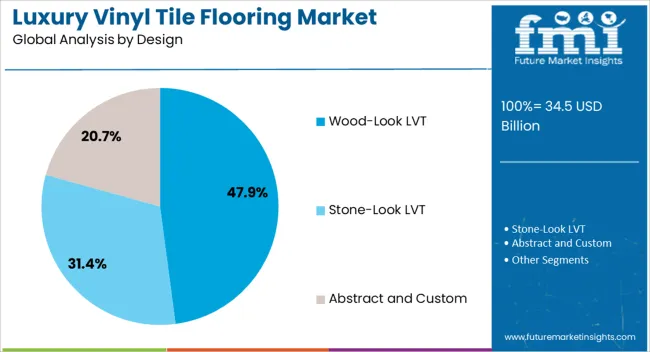
Wood-look LVT leads the design category with a 47.9% market share, driven by its ability to replicate the aesthetics of hardwood flooring at a fraction of the cost. This design type has gained popularity among consumers who desire the warmth and elegance of wood without its maintenance challenges and vulnerability to moisture.
The evolution of high-definition printing and embossing techniques has enabled manufacturers to offer highly realistic textures and grain patterns, further enhancing consumer appeal. This segment benefits from its compatibility with various interior styles, ranging from rustic to contemporary, making it a preferred choice in residential renovations and new construction alike.
As homeowners and designers continue to seek visually compelling yet functional flooring solutions, wood-look LVT is expected to maintain strong market presence. Its resilience, affordability, and design range position it as a central element in the overall growth of the LVT flooring market
LVT flooring offers the look and feel of natural materials like wood and stone, but at a lower cost and with easier maintenance. The market is driven by rising demand for high-quality, cost-effective flooring solutions, particularly in residential and commercial applications. The growth of the construction and real estate sectors, particularly in emerging economies, is also fueling the demand for LVT. However, challenges such as the availability of counterfeit or low-quality products, as well as the environmental impact of some LVT manufacturing processes, are concerns. Opportunities lie in product innovation, including the development of environmentally-friendly LVT options, and the increasing preference for online retail channels.
The demand for luxury vinyl tile (LVT) flooring is largely driven by consumers' desire for affordable yet durable flooring solutions that do not compromise on aesthetics. LVT offers a high-end appearance that mimics natural materials such as hardwood, stone, and ceramic, at a fraction of the cost. It is especially popular in both residential and commercial spaces for its resilience to scratches, stains, and moisture, making it an ideal choice for high-traffic areas. As homeowners, builders, and property developers increasingly look for cost-effective, visually appealing, and low-maintenance flooring options, the demand for LVT is rising. This growth is also supported by the expansion of the construction and real estate sectors, particularly in emerging markets where affordable luxury solutions are in high demand.
The luxury vinyl tile (LVT) flooring market faces challenges related to the quality of products and environmental concerns. While LVT offers significant benefits in terms of cost and performance, the market is also saturated with low-quality and counterfeit products that can damage the reputation of manufacturers. Ensuring product consistency, durability, and the absence of harmful chemicals is critical. The production of LVT flooring can involve materials such as PVC, which has raised environmental concerns regarding its sustainability and the impact of its disposal. Manufacturers are under increasing pressure to address these concerns and develop more eco-friendly alternatives, particularly in response to growing consumer demand for sustainable products. These challenges create a competitive environment, as companies strive to balance quality, cost-effectiveness, and environmental responsibility.
Opportunities in the LVT flooring market lie in product innovation and the expansion of online retail platforms. As consumers seek more customization options, manufacturers are focusing on developing a wider variety of designs, textures, and finishes that mimic natural materials like hardwood, marble, and stone. The advancements in LVT technology, such as improved click-lock installation systems, have made it easier for consumers to install the flooring themselves, increasing its appeal. The growing trend of online shopping also presents a significant opportunity for LVT manufacturers, as e-commerce platforms allow for greater reach and convenience for consumers. Companies that invest in online sales channels, product diversification, and technological innovation are positioned to capture a larger market share as consumer preferences evolve.
The LVT flooring market is witnessing a trend toward the use of eco-friendly materials and advanced installation technologies. With increasing awareness of environmental sustainability, many manufacturers are shifting toward producing LVT products using recycled materials or bio-based alternatives. The demand for easier, quicker, and more efficient installation methods is pushing the development of click-lock technologies that eliminate the need for adhesives and reduce installation time. These innovations not only improve the product's appeal but also contribute to a more sustainable flooring solution. As consumers and businesses continue to seek environmentally responsible and user-friendly options, manufacturers are increasingly focused on providing LVT solutions that align with these expectations.
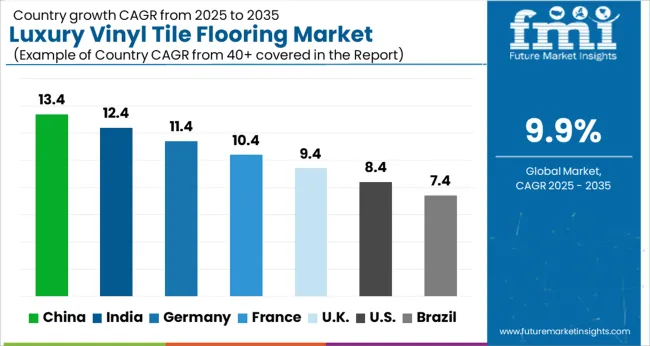
| Country | CAGR |
|---|---|
| China | 13.4% |
| India | 12.4% |
| Germany | 11.4% |
| France | 10.4% |
| UK | 9.4% |
| USA | 8.4% |
| Brazil | 7.4% |
The global luxury vinyl tile (LVT) flooring market is projected to grow at a CAGR of 9.9% from 2025 to 2035. China leads the market with the highest growth rate of 13.4%, followed by India at 12.4%. France, the UK, and the USA show moderate growth at 10.4%, 9.4%, and 8.4%, respectively. The market is driven by increasing urbanization, rising disposable incomes, and the growing demand for cost-effective, durable, and stylish flooring solutions. Additionally, the expansion of e-commerce platforms and the increasing trend of home renovation are expected to further fuel market growth. The analysis includes over 40 countries, with the leading markets shown below.
The luxury vinyl tile (LVT) flooring market in China is projected to grow at a CAGR of 13.4% from 2025 to 2035. The growing urbanization, real estate development, and rising disposable income are driving demand for high-quality, affordable, and aesthetically pleasing flooring solutions. LVT, known for its durability, easy maintenance, and variety of designs, is increasingly preferred for both residential and commercial applications. China’s rapid construction activities, particularly in the commercial and residential real estate sectors, are expected to continue driving the demand for LVT flooring. The growing trend of home improvement, combined with the increasing adoption of modern interior designs, is contributing to the market’s expansion. Online sales platforms are also gaining traction in China, making LVT products more accessible to consumers across urban and rural areas.
The luxury vinyl tile (LVT) flooring market in India is expected to grow at a CAGR of 12.4% from 2025 to 2035. The demand for LVT flooring in India is primarily driven by the rapid urbanization, an expanding middle class, and increasing disposable incomes. As residential and commercial spaces evolve, consumers are becoming more conscious of the aesthetics, durability, and affordability of flooring solutions. LVT is gaining popularity in India due to its versatility and cost-effectiveness compared to traditional flooring options like hardwood and marble. As the real estate sector grows and interior design trends shift, LVT flooring is being seen as a suitable option for modern homes and offices. The rise of e-commerce platforms also plays a crucial role in increasing product availability and consumer awareness.
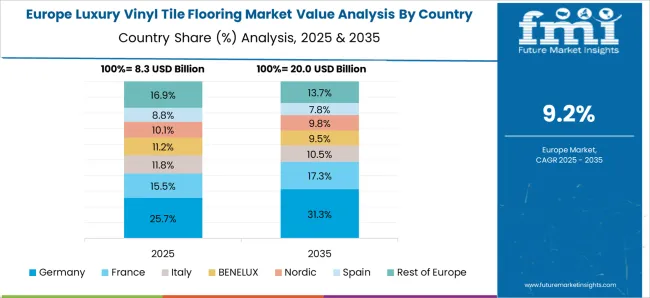
The luxury vinyl tile (LVT) flooring market in France is projected to grow at a CAGR of 10.4% from 2025 to 2035. LVT flooring is increasingly becoming a popular choice among French homeowners and businesses due to its affordability, durability, and variety of designs that cater to modern interior aesthetics. France’s strong real estate sector, combined with the growing demand for easy-to-maintain and long-lasting flooring, has significantly boosted the market for LVT flooring. As the trend of renovation and home improvement continues to gain momentum, the preference for LVT as a modern and versatile flooring solution is expected to rise. The commercial sector, including hospitality and retail, is also contributing to the growth of the LVT market in France.
The UK luxury vinyl tile (LVT) flooring market is expected to grow at a CAGR of 9.4% from 2025 to 2035. The growing trend of home renovation, especially post-pandemic, along with the increasing popularity of modern and stylish flooring solutions, is driving the demand for LVT flooring in the UK LVT is favored for its ability to replicate natural materials such as wood and stone while offering a more affordable, durable, and maintenance-free option. As the housing market continues to grow and the demand for stylish, cost-effective flooring solutions increases, LVT is being seen as the preferred choice for many consumers. The rise of online retail platforms in the UK is further contributing to the growth of LVT sales.
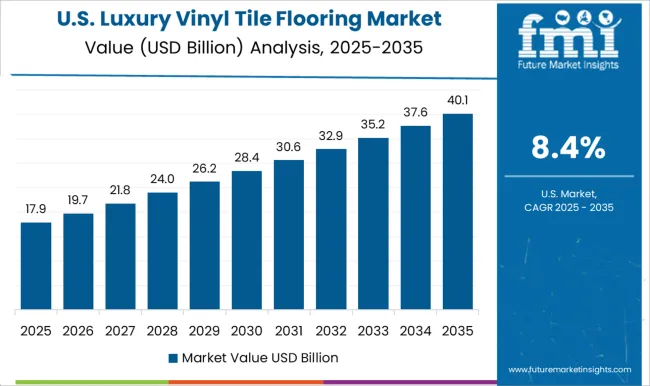
The USA luxury vinyl tile (LVT) flooring market is projected to grow at a CAGR of 8.4% from 2025 to 2035. LVT is gaining significant traction in both residential and commercial sectors due to its aesthetic appeal, durability, and cost-effectiveness compared to traditional flooring materials. As USA consumers seek modern, versatile, and low-maintenance flooring solutions, LVT is becoming increasingly popular in home renovation projects. The commercial sector, including retail and hospitality, is contributing to the growth of LVT flooring demand. With the increasing trend of DIY home improvement, consumers are opting for LVT as an easy-to-install and visually attractive flooring option.
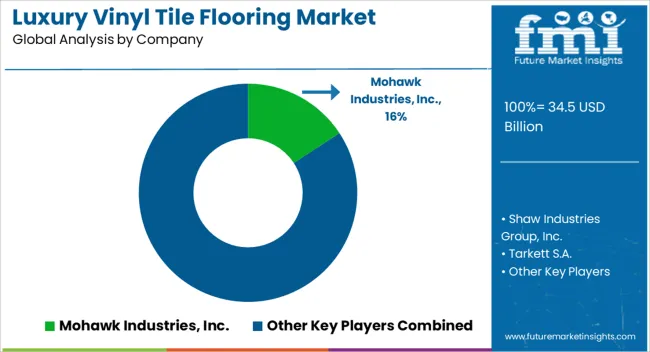
The luxury vinyl tile (LVT) flooring market is highly competitive, with leading manufacturers focusing on quality, design innovation, and ease of installation. Mohawk Industries, Inc. leads the market with a comprehensive range of LVT flooring solutions, prioritizing durability, aesthetic variety, and easy maintenance. Their strategy includes leveraging cutting-edge technology to enhance product performance, with a strong emphasis on sustainability and eco-friendly manufacturing processes.
Shaw Industries Group, Inc. competes with an extensive collection of LVT options, known for high-quality finishes and advanced wear resistance. Shaw emphasizes performance-driven products, offering residential and commercial flooring solutions with enhanced scratch and stain resistance. Tarkett S.A. and Armstrong Flooring, Inc. position themselves with strong product portfolios in the LVT segment. Tarkett focuses on sustainable innovation, integrating eco-friendly materials into their LVT products. Their solutions are designed to combine aesthetic appeal with environmental responsibility.
Armstrong Flooring, known for its premium, high-performance LVT products, emphasizes versatility and long-lasting durability. Their strategy revolves around providing customizable flooring solutions for both commercial and residential markets, ensuring products that meet diverse design and functional needs. Mannington Mills, Inc. and Interface, Inc. compete by offering durable, high-quality LVT flooring options. Mannington targets a wide range of consumer preferences, offering LVT designs that mimic natural materials like wood and stone, providing aesthetic appeal at a fraction of the cost.
Interface emphasizes modularity and sustainability, offering LVT that suits both residential and commercial applications, with a focus on low environmental impact. Companies like Congoleum Corporation, Beaulieu International Group, and Karndean Designflooring focus on expanding their product lines to appeal to various customer needs, including customizable colors, textures, and installation options. Product brochures from these companies highlight the variety of designs, ease of maintenance, durability, and cost-effectiveness. Many emphasize features like scratch resistance, waterproof qualities, and simple installation techniques. Sustainability and product innovation are often key selling points, ensuring LVT products remain a top choice for consumers seeking functional, stylish flooring solutions.
| Items | Values |
|---|---|
| Quantitative Units | USD 34.5 billion |
| Type | Rigid and Flexible |
| Product Type | Glue-Down LVT, Click LVT, Loose Lay LVT, and Self-Adhesive LVT |
| Design | Wood-Look LVT, Stone-Look LVT, and Abstract and Custom |
| End-use | Residential Housing, Commercial Spaces, Healthcare Facilities, and Others |
| Regions Covered | North America, Europe, Asia-Pacific, Latin America, Middle East & Africa |
| Country Covered | United States, Canada, Germany, France, United Kingdom, China, Japan, India, Brazil, South Africa |
| Key Companies Profiled | Mohawk Industries, Inc., Shaw Industries Group, Inc., Tarkett S.A., Armstrong Flooring, Inc., Mannington Mills, Inc., Interface, Inc., Congoleum Corporation, Beaulieu International Group, Forbo Flooring Systems, Gerflor Group, Karndean Designflooring, Novalis Innovative Flooring, Metroflor Corporation, EarthWerks, and LG Hausys America, Inc. |
| Additional Attributes | Dollar sales of flooring span planks and tiles, applied in residential and commercial spaces, with wood-, stone-, and abstract-look styles. Growth is fueled by durability, sustainability, premium demand, urbanization, and expanding construction worldwide. |
The global luxury vinyl tile flooring market is estimated to be valued at USD 34.5 billion in 2025.
The market size for the luxury vinyl tile flooring market is projected to reach USD 88.7 billion by 2035.
The luxury vinyl tile flooring market is expected to grow at a 9.9% CAGR between 2025 and 2035.
The key product types in luxury vinyl tile flooring market are rigid and flexible.
In terms of product type, glue-down lvt segment to command 41.3% share in the luxury vinyl tile flooring market in 2025.






Full Research Suite comprises of:
Market outlook & trends analysis
Interviews & case studies
Strategic recommendations
Vendor profiles & capabilities analysis
5-year forecasts
8 regions and 60+ country-level data splits
Market segment data splits
12 months of continuous data updates
DELIVERED AS:
PDF EXCEL ONLINE
Luxury Travel Market Forecast and Outlook 2025 to 2035
Luxury Wood Doors For Residential Interiors Market Size and Share Forecast Outlook 2025 to 2035
Luxury Packaging Market Size and Share Forecast Outlook 2025 to 2035
Luxury Rigid Box Market Size and Share Forecast Outlook 2025 to 2035
Luxury Hotel Market Size and Share Forecast Outlook 2025 to 2035
Luxury Electric Vehicle (EV) Market Size and Share Forecast Outlook 2025 to 2035
Luxury Car Market Size and Share Forecast Outlook 2025 to 2035
Luxury Mattress Market Size and Share Forecast Outlook 2025 to 2035
Luxury Fine Jewellery Market Analysis - Size, Share, and Forecast 2025 to 2035
Luxury SUV Market Size and Share Forecast Outlook 2025 to 2035
Luxury Plumbing Fixtures Market Size and Share Forecast Outlook 2025 to 2035
Luxury Coaches Market Size and Share Forecast Outlook 2025 to 2035
Luxury Interior Fabric Industry Analysis in North America and Europe Growth, Trends and Forecast from 2025 to 2035
Luxury Footwear Market Outlook – Size, Share & Innovations 2025 to 2035
Luxury Furniture Market Insights - Demand, Size, and Industry Trends 2025 to 2035
Competitive Overview of Luxury Yacht Market Share & Providers
Luxury Yacht Industry Analysis by Type, by Size, by Application , by Ownership, and by Region- Forecast for 2025 to 2035
Luxury Handbag Market Analysis by Product Type, Material Type, and Region Through 2035
Luxury Products For Kids Market - Trends, Growth & Forecast 2025 to 2035
Market Share Breakdown of Luxury Rigid Box Manufacturers

Thank you!
You will receive an email from our Business Development Manager. Please be sure to check your SPAM/JUNK folder too.
Chat With
MaRIA